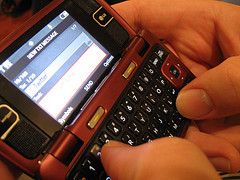Is Twitter Classroom Worthy?
June 29, 2010
 I have a confession to make. I spend more time sending out Twitter updates (commonly called tweets) than I do on email these days.
I have a confession to make. I spend more time sending out Twitter updates (commonly called tweets) than I do on email these days.
Why is it a confession? Twitter has gotten a bad reputation in some circles. The College Humor video Twitter in Real Life demonstrates the way many people perceive the world of Twitter—it’s all a bunch of random, mediocre comments about whatever the writer happens to be doing at the moment in time.
Just because you can use Twitter for random reports on your day, however, doesn’t meant that you have to use it that way. In fact, I’d argue that a lot of the updates on Twitter are anything but random and mediocre when they are read by the intended audience in the appropriate context.
Yep, it’s all about the rhetorical situation. There are lots of people using Twitter to publish status updates about projects, news, and their lives in ways that are anything but random. Take @BreakingNews for instance. All day long, every day, the editors post the latest news stories in 140 characters or less, often with a link to a page with more information.
Looking for a more local example? The town where I live posts regular updates about road construction, town planning, town council meetings, and special events as @Blacksburg_Gov. Virginia Tech, my local university, posts similar updates as @vt_edu and @vtnews.
But is Twitter classroom worthy? Obviously, you can send similar class information and news to students using Twitter, but is the social networking tool capable of more than simply class announcements? Absolutely.
If you’re unsure, think about Twitter as another of the many ways that students can publish their writing. Make it one of the tools in your arsenal, placing it alongside blog posts, Wikipedia updates, email messages, and web forum posts.
Now any one of those tools for publishing writing can be used in mediocre ways that are not worthy of classroom exploration. That’s where the teacher comes in. The teacher has to talk about the audience and purpose for the messages and help students find the most effective ways to communicate—whether students are using blogs, email messages or Twitter.
Now just how do you go about it? Come back later this week for tips on how to introduce Twitter and ways to use Twitter in the classroom.